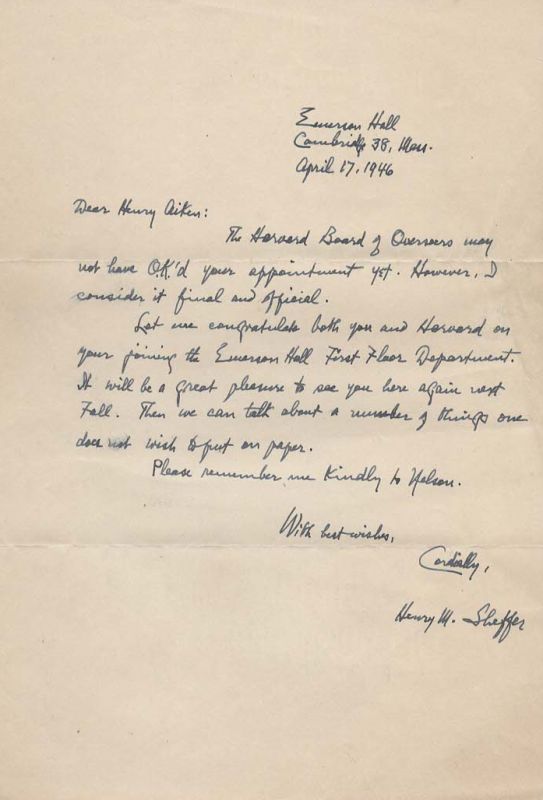[Aiken, Manuscript Letter signed from eminent american logician, Henry M. Sheffe
Manuscript Letter signed from eminent american logician, Henry M. Sheffer, to Philosopher Henry David Aiken, congratulating Aiken of being accepted to Harvard: “…..the Harvard Board of Overseers may not have O.K.‘d your appointment yet. However, I consider it final and official. Letme congratulate both you and Harvard on your joining the Emerson Hall First Floor Department. It will be a great pleasure to see you here again next Fall….”. Sheffer then continues ominously: “Then we can talk about a number of things one does not wish to put on paper”.
Cambridge (Emerson Hall), April 17th, 1946. Octavo. 1 pages. Softcover. Very good condition with only minor signs of wear. Original Letters or anything published by Sheffer, is exceedingly rare !
Henry Maurice Sheffer (1 September 1882 – 17 March 1964) was an American logician.
Sheffer was a Polish Jew born in the western Ukraine, who immigrated to the USA in 1892 with his parents and six siblings. He studied at the Boston Latin School before entering Harvard University, learning logic from Josiah Royce, and completing his undergraduate degree in 1905, his master’s in 1907, and his Ph.D. in philosophy in 1908.
Sheffer was a postdoctoral fellow at Harvard, and then taught University of Washington, Cornell, the University of Minnesota, the University of Missouri, and City College of New York for one year each. In 1916, he was hired by Harvard as a philosophy professor, where he stayed until he retired in 1952.
Sheffer proved in 1913 that Boolean algebra could be defined using a single primitive binary operation, “not both . . . and . . .”, now abbreviated NAND, or its dual NOR, (in the sense of “neither . . . nor”). Likewise, the propositional calculus could be formulated using a single connective, having the truth table either of the logical NAND, usually symbolized with a vertical line called the Sheffer stroke, or its dual logical NOR (usually symbolized with a vertical arrow or with a dagger symbol). Charles Peirce had also discovered these facts in 1880, but the relevant paper was not published until 1933. Sheffer also proposed axioms formulated solely in terms of his stroke.
Sheffer introduced what is now known as the Sheffer stroke in 1913; it became well known only after its use in the 1925 edition of Whitehead and Russell’s Principia Mathematica. Sheffer’s discovery won great praise from Bertrand Russell, who used it extensively to simplify his own logic, in the second edition of his Principia Mathematica. Because of this comment, Sheffer was something of a mystery man to logicians, especially because Sheffer, who published little in his career, never published the details of this method, only describing it in mimeographed notes and in a brief published abstract. W. V. Quine’s Mathematical Logic also made much of the Sheffer stroke.
A Sheffer connective, subsequently, is any connective in a logical system that functions analogously: one in terms of which all other possible connectives in the language can be expressed. For example, they have been developed for quantificational and modal logics as well. (Wikipedia)
- Keywords: Aiken, Henry David · Autograph – Rare · Autographed Letter – signed · Henry David Aiken – Collection · Knopf, Alfred A. [Publisher New York] · Library & Collection Building · Manuscript / Autograph – Rare · Manuscript Letter Rare · Manuscript Letter Signed · Philosophy Rare · Publishing History · Typed Letter signed
- Language: English
- Inventory Number: 31869AB
© 2026 Inanna Rare Books Ltd. | Powered by HESCOM-Software










